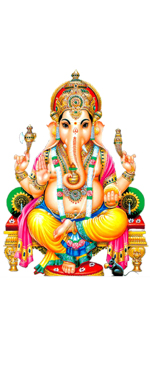Lord Ganesha was born on the fourth day after the Amavasya in the month of Bhadrapada. The birth of Lord Ganesha is in Hastha Nakshatra and Kanya Rashi. The Indian Scriptures says that Lord Ganesha was created by the Goddess Parvati as a guardian to her privacy. The story of the birth of the Lord Ganesha, as described in Shiva Purana, goes like this:-Once Goddess Parvati, while bathing, created an idol of a boy out of the dirt of her body, declaring him to be her own son. He was named as Ganesha. She instructed Lord Ganesha to guard the cave where she was taking bath. Soon after that Lord Shiva came to meet Goddess Parvati, but Ganesha blocked his way and did not allow Lord Shiva to enter the Parvati-Kaksha. Lord Shiva, who was unaware about the fact that this boy was his very own son, got furious and decided to fight with Ganesha. In his divine fury, Lord Shiva cut the head of Lord Ganesha from his body. When Goddess Parvati learned of this, she was so enraged and insulted that in aggrieved anguish she decided to destroy the entire creation. Lord Shiva, by now realized his mistake and agreed to bring back Ganesha’s life. He sent out his Ganas and other Devtas to bring the head of the first living being from the north direction. They soon returned with the head of strong and powerful elephant. Lord Shiva placed the head onto Ganesha’s body. Breathing new life into him, he declared Ganesha to be his own son as well, and gave him the status of being foremost among the Gods.

Puja of various forms of Lord Ganesha & Benefits gained by this puja :
Mantra for Lord Ganesha : "Vakratunndd Mahakaya Suryakoti Samah Prabha, Nirvighnam Kurumedev, Sarva Karyeshu Sarvada"This means :- O Lord Ganesha of large body, curved trunk, with a brilliance of million Suns, please make my work always free of obstacles.
Sphatik (Crystal ) Ganpati : Crystal Ganesha idol harmonize the aura around us and remove the negative energy. Therefore when we place this crystal Ganesha ji in our house or office, the place is purified by the power of crystal and the blessings of Lord Ganesha are attained.
Shwetarak Ganpati : Shwetarak Ganpati is one of the rarest and sacred form of Lord Ganesha. In our shastra, it is laid down that in any house where white (Shwetarak) Ganapati is present, the house remains free from all evils and the residents are blessed with immense wealth. Establish the idol of Shwetark Ganesha in the East direction of the house, on a Red cloth and he should be worshipped with Red flowers, Red sandalwood and Urad dal. Chant the following mantra while offering your prayers to the Lord, "Om Vakratundaya Hum" with full devotion & faith.
Ganesha Rudraksha : This kind of Rudraksha bears trunk like elevation as is seen on the face of Lord Ganesha. Therefore it is called Ganesha Rudraksha. This Rudraksha represents Lord Ganesha. This Rudraksha has a natural protrusion similar to the trunk of Lord Ganesha. When invoked, it blesses the wearer with progress and lessens the obstacles in the wearer’s path. It is beneficial for students who want to achieve great success in their career.